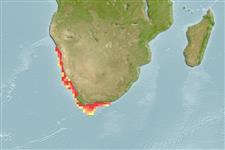Malacostraca |
Decapoda |
Palinuridae
Environment: milieu / climate zone / depth range / distribution range
Ecology
Benthic; depth range 0 - 200 m (Ref. 4). Subtropical, preferred 18°C (Ref. 107945); 21°S - 37°S, 12°E - 26°E (Ref. 4)
Southeast Atlantic: Namibia to South Africa.
Length at first maturity / Size / Weight / Age
Maturity: Lm 6.6, range 5 - ? cm Max length : 46.0 cm BL male/unsexed; (Ref. 4)
It has a maximum total body length of 46 cm and a carapace length of 18 cm. Maximum depth from Ref. 113432. Fisheries: The tails of this species are exported frozen in the shell, or peeled and canned. Experimental work on culture techniques for this species are underway in South Africa. Protective measures includes a size limit (carapace length 8.5 cm), a closed season from July 1 to October 31, bag limits for sports fishermen (2 specimens per day), and the prohibition of taking ovigerous females or soft shelled specimens (Ref. 4). Occurs at depths from 0 to 46 m of coastal waters and inhabits rocky bottoms, sometimes with patches of sand and mud (Ref. 4).
Life cycle and mating behavior
Maturity | Reproduction | Spawning | Eggs | Fecundity | Larvae
The males molt between September and December. In the females, molting occurs in April or May, after which copulation takes place. Ovigerous females are found from May to October (Ref. 4).
Holthuis, L.B. 1991 FAO Species Catalogue. Vol. 13. Marine lobsters of the world. An annotated and illustrated catalogue of species of interest to fisheries known to date. FAO Fish. Synop. 125(13):292p. Rome: FAO. (Ref. 4)
IUCN Red List Status
(Ref. 130435: Version 2025-1)
CITES status (Ref. 108899)
Not Evaluated
Not Evaluated
Threat to humans
Human uses
Fisheries: commercial
FAO - Fisheries: landings | FishSource | Sea Around Us
Tools
More information
PhysiologyOxygen consumption
Human RelatedStamps, coins, misc.
Internet sources
Estimates based on models
Preferred temperature
(Ref.
115969): 14.6 - 19.5, mean 16.7 (based on 12 cells).
Resilience
Low, minimum population doubling time 4.5 - 14 years (K=0.1-0.11).
Fishing Vulnerability
High vulnerability (56 of 100).
Climate Vulnerability
Very high vulnerability (85 of 100).
Nutrients : Calcium = 109 [35, 184] mg/100g; Iron = 1.59 [1.21, 1.97] mg/100g; Protein = 20.2 [19.2, 21.3] %; Omega3 = 0.285 [0.185, 0.386] g/100g; Selenium = 48.3 [-31.7, 128.3] μg/100g; VitaminA = 0 μg/100g; Zinc = 1.79 [1.17, 2.40] mg/100g (wet weight); based on
nutrient studies.
